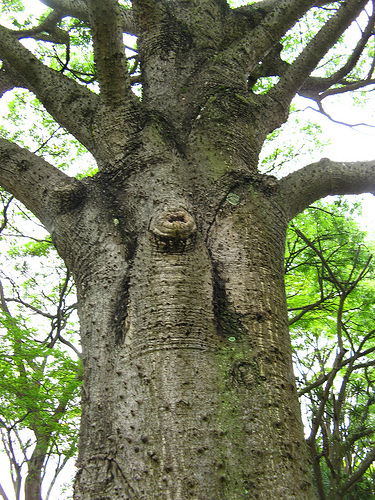
Share
Mechanisms to incentivize the re-establishment and scaling up of native species forest plantations in the State of Sao Paulo, Brazil
CHALLENGE
Brazil’s Forest Code requires all private landowners to retain the original forest or woodland on 20% of their land to ensure the provision of ecosystem services. Over the years, however, due to poor enforcement of the law, most landowners have not kept adequate areas devoted to forest reserves ("Reserva Legal"). The New Forest Code (Law 12.651/2014) now allows the re-establishment of the forest reserve either on-farm or on other private and public lands that are currently degraded or under-utilized. In an effort to facilitate compliance, the new Forest Code also allows new generation forest plantations of native species that can be harvested, provided adequate attention is devoted to maintaining their ecosystem services (protection of watersheds and biological diversity).
APPROACH
The program consists of four elements:
- Review of the economic and financial analysis of the proposed models, carried out by the State Secretariat for Environment (Secretaria do Meio Ambiente, SMA) in Sao Paulo, jointly with the Institute for Forest Research and Studies (IPEF).
- Market study, which evaluates the market potential for key products considered under the replanting program by adapting the value chain approach already used under PROFOR.
- Design of financing instruments, based on the review of existing instruments and dialogue with financing institutions.
- Dissemination/Knowledge exchange which involves disseminating results of the study in three languages: Portuguese, English, and Spanish.
RESULTS
This activity is ongoing, to date. The following studies were completed:
(a) Assessing, validating, and adjusting, as needed, the analysis carried out on the economic viability of the proposed sustainable forest management (SFM) models
(b) Assessing market potential for wood products (See attached report by Amantino Ramos de Freitas and summary by Maria Isabel Braga.)
(c) Evaluating existing studies and information, and implementing additional studies to fill existing information gaps, aiming at the elaboration of a business model for a multipurpose pilot forestry pole in the Paraíba do Sul River Basin
(d) Defining a research and development agenda based on what has already been done regarding forest restoration in the Mata Atlântica and Amazon biomes, and on an analysis of potential benefits based on the results of research already completed
Some key findings so far are:
- All studies agreed that returns of investments in native species plantations could be high. Yet the level of risk is so high that in practice it is rare to find significant scale investments in native species. The time required for native species to produce valuable timber is significantly longer than the two exotic species that are produced on a large scale in Brazil, Eucalyptus and Pinus. This long period to recuperate the investment generates risks that are difficult to overcome. Research and development, which can reduce risks and variability of performances, can contribute to mitigate such risks. In addition, it is important to increase the emphasis on non-timber products (like fruits, palm hearth, and so on), which can reduce the period required to recuperate the investment.
- Research and development (R&D) to scale up native species silviculture in Brazil. The study proved that, in some situations, planting native trees in Brazil can be a good yet risky business.
- The study identified 30 native species with higher potential for commercial production of timber (15 species from the Atlantic biome and 15 from the Amazonian biome). Specific gaps and priorities were identified in eight research areas: (i) seeds and seedlings, (ii) forestry breeding and improvement, (iii) wood technology, (iv) topo climatic zoning, (v) forestry management, (vi) vegetative propagation, (vii) market for wood products, and (viii) policy and legislation.
- The results have found that the cost to develop 30 species is around US$8 million over 20 years. The estimated results are as follows: (a) productivity to increase in the range of 25 percent in the short term and from 56 percent to 85 percent in the medium and long term, (b) forestry costs to decrease by 20 percent, and (c) round wood to lumber conversion rates from 20 percent to 40 percent in thinning, and from 40 percent to 50 percent in the final cut. Together, these three variables could possibly increase and impact IRR up by 5 percent, making forestry with native species viable in Brazil, with a risk adjusted return comparable to mainstream investments such as eucalyptus plantations.
- For every US$1 dollar invested in R&D, there is an estimated gain of US$2.4 in benefits, with a necessary scale of at least 10,000 hectares to justify investments in R&D. In terms of scale, this means that US$8 million is needed for R&D plus US$100 million for forest assets (US$10,000 per hectare over 30 years). Based on the potential future market demand of tropical timber species, the study estimated a potential of more than 1 million hectares for silviculture with native species to meet future demand tropical lumber by the year 2050, corresponding to more than 10 percent of the Brazilian Nationally Determined Contribution target on restoration of degraded lands. The next step is to identify the specific interests of the multilateral agencies, public sector, private companies and financial sector to actually invest in such development program and native forestry plantation assets.
These findings are informing a concept note for a new project proposal to the World Bank for implementation of commercially viable multi-purpose native tree forests.
More findings and results will be shared on this page when they become available.
For stories and updates on related activities, follow us on twitter and facebook , or subscribe to our mailing list for regular updates.
Last Updated : 06-16-2024








